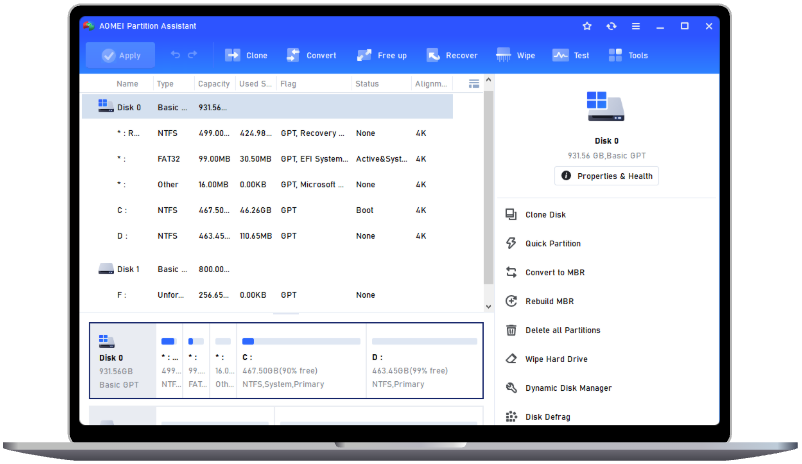[Solved]: How to Upgrade HDD Space on PCs?
This article offers a detailed, step-by-step guide on how to upgrade HDD space on PCs. Whether you're looking to replace your current drive with a larger one or simply need extra storage, this guide provides clear instructions to help you achieve your goal.
I’m running out of storage on my PC and want to upgrade my 1TB HDD to a larger one, like 2TB or 4TB. I’ve never done this before, so I’m not sure where to start. What’s the best way to upgrade HDD space without losing my data?
- Question from User
Over time, your hard drive may run out of space, leaving you with limited capacity for storing data. This can be a terrible issue, especially when you need to store important files or install new programs. Worse yet, low disk space can negatively impact your system's performance and even cause crashes.
If you're looking to upgrade your HDD space on your PC, you're in the right place. This article offers a detailed, step-by-step guide on how to upgrade HDD space on PCs. Please keep reading to find the best ways to optimize your disk management.
How to Upgrade HDD Space on PCs?
If your computer is running out of storage, upgrading your HDD is a good solution. By replacing your existing hard drive with a larger one, you can get more space to store files, run applications, and improve system performance.
To replace your drive, it is recommended to use a disk cloning tool like AOMEI Partition Assistant. This powerful and user-friendly tool enables you to clone a disk/a specific partition, or only migrate the OS to another drive. With it, you can quickly and safely transfer all content, like the OS, personal data, videos, music, and apps, ensuring everything works the same as on the original drive. Additionally, it also offers features like partition resizing and formatting, which makes disk management easier.
Here’s how to upgrade HDD space on PCs using this software:
Step 1. Open the installed AOMEI Partition Assistant, click "Clone" in the main interface, and select "Clone Disk".
Step 2. Choose the hard disk that you need to clone as the source disk like SSD and click "Next".
Step 3. Select the destination disk to store the data on the source disk, and then click "Next".
Step 4. Then, you can check the source and destination disk in the next window or change to "Sector to Sector clone", and click the "Confirm" button to continue if there is no problem.
Here, you can also click the "Settings" button to adjust the partition size on the destination disk. If the target disk is an SSD drive, you can tick "4k alignment" to optimize its performance.
Step 5. After returning to the main interface, check the pending operation and click "Apply" and "Proceed" to commit the operation.
Additional Ways to Increase HDD Space
How do I increase my hard drive space without replacing it? Here are several effective methods you can use to free up space and optimize your existing storage:
Fix 1. Remove Unnecessary Files
Over time, your hard drive can become cluttered with unnecessary files, such as temporary files, cached data, and old downloads. Removing these items can free up significant space. Here’s how to increase HDD space by removing unnecessary files
Step 1. Launch AOMEI Partition Assistant, click “Free up” in the top toolbar, and choose “PC Cleaner”.
Step 2. Click "Start Scan" button to scan junk files in the PC.
Step 3. Wait for a while to scan the junk files.
Step 4. Some junk files will be selected automatically, you can directly click "Clean All" or tick other unneeded files.
Fix 2. Uninstall Unused Programs
If your drive is still full after removing unnecessary files, consider uninstalling unused programs to free up space. Here’s how to do it:
Step 1. In the search box on the lower left of your desktop, type “control panel” and press Enter.
Step 2. In the popup windows, click on “Programs” > “Programs and Features”.
Step 3. Then, all apps and programs will be listed. Right-click the one you want to delete and select “Uninstall” to remove it from your PC.
Fix 3. Move Files to an External Storage Device
Alternatively, you can move large files like videos, photos, and backups to an external storage device. For example, you can store these files on an external hard drive. Here’s how to do it:
Step 1. Connect an external hard drive to your PC.
Step 2. Open File Explorer and locate the files you no longer need immediate access to. Then, simply drag and drop them into the external drive.
Step 3: Once the transfer is complete, open the external drive to ensure all files are intact. After verifying the files, you can delete them from your original drive to free up disk space.
Summary
Running out of HDD space? Don’t worry! This guide on how to upgrade HDD space on your PC will show you how to either replace your existing drive with a larger one or use other methods to increase your storage. These solutions will help you reclaim valuable space and keep your PC running smoothly.
FAQs
Q1: How do I increase my hard drive space without replacing the HDD?
You can increase your hard drive space by removing unnecessary files, uninstalling unused programs, and moving applications to another drive.
Q2: Can I upgrade my HDD to an SSD?
Yes, you can replace your HDD with an SSD for faster performance and more storage space. AOMEI Partition Assistant can help you clone an HDD to an SSD.
Q3: What should I do if my HDD is still full after cleaning?
If your HDD is still full after cleaning, consider upgrading to a larger drive or using an external hard drive for additional storage.


